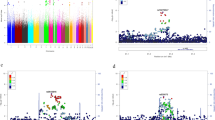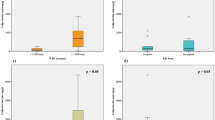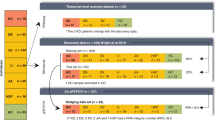Abstract
Kawasaki disease (KD) is an acute systemic vasculitis syndrome of infants and young children. Although its etiology is largely unknown, epidemiological findings suggest that genetic factors play a role in the pathogenesis of KD. To identify genetic factors, affected sib-pair analysis has been performed. One of the identified peaks was located on the Xq26 region. A recent report of elevated expression of CD40 ligand (CD40L), which maps to Xq26, during the acute-phase KD, and its relationship to the development of coronary artery lesions (CAL) prompted us to screen for polymorphism of CD40L and to study the association of the gene to KD. A newly identified SNP in intron 4 (IVS4+121 A>G) is marginally over-represented in KD patients as compared to controls (109/602, 18.1 vs 111/737, 15.1%). When male KD patients with CAL were analyzed as a patient group, the SNP was significantly more frequent than in controls (15/58, 25.9%, vs 111/737, 15.1%, OR=2.0, 95% CI=1.07–3.66; P=0.030). Interestingly, this variation was extremely rare in a control Caucasian population (1/145, 0.7%). Our results suggest a role of CD40L in the pathogenesis of CAL and might explain the excess of males affected with KD.
Similar content being viewed by others
Log in or create a free account to read this content
Gain free access to this article, as well as selected content from this journal and more on nature.com
or
References
Kawasaki T : Pediatric acute febrile mucocutaneous lymph node syndrome with characteristic desquamation of fingers and toes: my clinical observation of 50 cases (in Japanese). Jpn J Allergy 1967; 16: 178–222.
Kato H, Koike S, Yamamoto M, Ito Y, Yano E : Coronary aneurysms in infants and young children with acute febrile mucocutaneous lymph node syndrome. J Pediatr 1975; 86: 892–898.
Taubert KA, Rowley AH, Shulman ST : Seven-year national survey of Kawasaki disease and acute rheumatic fever. Pediatric Infect Dis J 1994; 13: 704–708.
Fujita Y, Nakamura Y, Sakata K et al: Kawasaki disease in families. Pediatrics 1989; 84: 666–669.
Uehara R, Yashiro M, Nakamura Y, Yanagawa H : Kawasaki disease in parents and children. Acta Paediatr 2003; 92: 694–697.
Dean AG, Melish ME, Hicks R, Palumbo NE : An epidemic of Kawasaki syndrome in Hawaii. J Pediatr 1982; 100: 552–557.
Yanagawa H, Nakamura Y, Yashiro M et al: Incidence survey of Kawasaki disease in 1997 and 1998 in Japan. Pediatrics 2001; 107: E33.
Wang CL, Wu YT, Liu CA et al: Expression of CD40 ligand on CD4+ T-cells and platelets correlated to the coronary artery lesion and disease progress in Kawasaki disease. Pediatrics 2003; 111: E140–E147.
Biancone L, Cantaluppi V, Camussi G : CD40–CD154 interaction in experimental and human disease (review). Int J Mol Med 1999; 3: 343–353.
Yellin MJ, Brett J, Matsushima A et al: Functional interactions of T cells with endothelial cells: the role of CD40L–CD40-mediated signals. J Exp Med. 1995; 182: 1857–1864.
Henn V, Slupsky JR, Grafe M et al: CD40 ligand on activated platelets triggers an inflammatory reaction of endothelial cells. Nature 1998; 391: 591–594.
Asano T, Ogawa S : Expression of IL-8 in Kawasaki disease. Clin Exp Immunol 2000; 122: 514–519.
Terai M, Jibiki T, Harada A et al: Dramatic decrease of circulating levels of monocyte chemoattractant protein-1 in Kawasaki disease after gamma globulin treatment. J Leukoc Biol 1999; 65: 566–572.
Asano T, Ogawa S : Expression of monocyte chemoattractant protein-1 in Kawasaki disease: the anti-inflammatory effect of gamma globulin therapy. Scand J Immunol 2000; 51: 98–103.
Nash MC, Shah V, Dillon MJ : Soluble cell adhesion molecules and von Wilebrand factor in children with Kawasaki disease. Clin Exp Immunol 1995; 101: 13–17.
Resarch Committee on Kawasaki Disease, Ministry of Health and Welfare: Report of Subcommittee on Standardization of Diagnostic Criteria and Reporting of Coronary Artery Lesions in Kawasaki Disease 1984.
Fukushima Y, Ohashi H, Wakui K, Nishida T, Oh-ishi T : A rapid method for starting a culture for the establishment of Epstein–Barr virus-transformed human lymphoblastoid cell lines. Jpn J Hum Genet 1992; 37: 149–150.
Sambrook and Russel: Molecular Cloning A Laboratory Manual, 3rd Edn. Cold Spring Harbor Laboratory Press: New York, pp 6.4–6.28.
Cordell HJ, Kawaguchi Y, Todd JA, Farral M : An extension of the Maximum Lod Score method to X-linked loci. Ann Hum Genet 1995; 59: 435–449.
Nyholt DR : All LODs are not created equal. Am J Hum Genet. 2000; 67: 282–288.
Lobo F, Xu S, Lee C, Fuleihan L : Transcriptional activity of the distal CD40 ligand promoter. Biochem Biophys Res Commun 2000; 279: 245–250.
Kosinski P, Laughlin J, Singh K, Covey L : A complex containing poly pyrimidine tract-binding protein is involved in regulating the stability of CD40 ligand (CD154) mRNA. J immunol 2003; 170: 979–988.
Hamilton BJ, Genin A, Cron RQ, Rigby WF : Delineation of a novel pathway that regulates CD154 (CD40 ligand) expression. Mol Cell Biol 2003; 23: 510–525.
Allen RC, Armitage RJ, Conley ME et al: CD40 ligand gene defects responsible for X-linked hyper-IgM syndrome. Science 1993; 259: 990–993.
Aruffo A, Farrington M, Hollenbaugh D et al: The CD40 ligand, gp39, is defective in activated T cells from patients with X-linked hyper-IgM syndrome. Cell 1993; 72: 291–300.
DiSanto JP, Bonnefoy JY, Gauchat JF, Fischer A, de Saint Basile G : CD40 ligand mutations in X-linked immunodeficiency with hyper-IgM. Nature 1993; 361: 541–543.
Sabeti P, Usen S, Farhadian S et al: CD40L association with protection from severe malaria. Genes Immun 2002; 3: 286–291.
Miller R, Miller P, Kwok P : Regions of low single-nucleotide polymorphism incidence in human and orangutan Xq: deserts and recent coalescences. Genomics 2001; 71: 78–88.
Sabeti PC, Reich DE, Higgins JM et al: Detecting recent positive selection in the human genome from haplotype structure. Nature 2002; 419: 832–837.
Acknowledgements
We thank all patients, their family members and all the medical staff for collaborating with this project. We also thank Jane C Burns (UCSD School of Medicine, La Jolla, CA) for helpful discussion and editing of the manuscript.
Author information
Authors and Affiliations
Corresponding author
Additional information
Supplementary information accompanies the paper on European Journal of Human Genetics website (http://www.nature.com/EJHG).
Rights and permissions
About this article
Cite this article
Onouchi, Y., Onoue, S., Tamari, M. et al. CD40 ligand gene and Kawasaki disease. Eur J Hum Genet 12, 1062–1068 (2004). https://doi.org/10.1038/sj.ejhg.5201266
Received:
Revised:
Accepted:
Published:
Issue date:
DOI: https://doi.org/10.1038/sj.ejhg.5201266
Keywords
This article is cited by
-
Identification of novel locus associated with coronary artery aneurysms and validation of loci for susceptibility to Kawasaki disease
European Journal of Human Genetics (2021)
-
Kawasaki disease: pathophysiology and insights from mouse models
Nature Reviews Rheumatology (2020)
-
Dissecting Kawasaki disease: a state-of-the-art review
European Journal of Pediatrics (2017)
-
The Roles of Ca2+/NFAT Signaling Genes in Kawasaki Disease: Single- and Multiple-Risk Genetic Variants
Scientific Reports (2014)
-
Genetic polymorphisms in Kawasaki disease
Acta Pharmacologica Sinica (2011)



